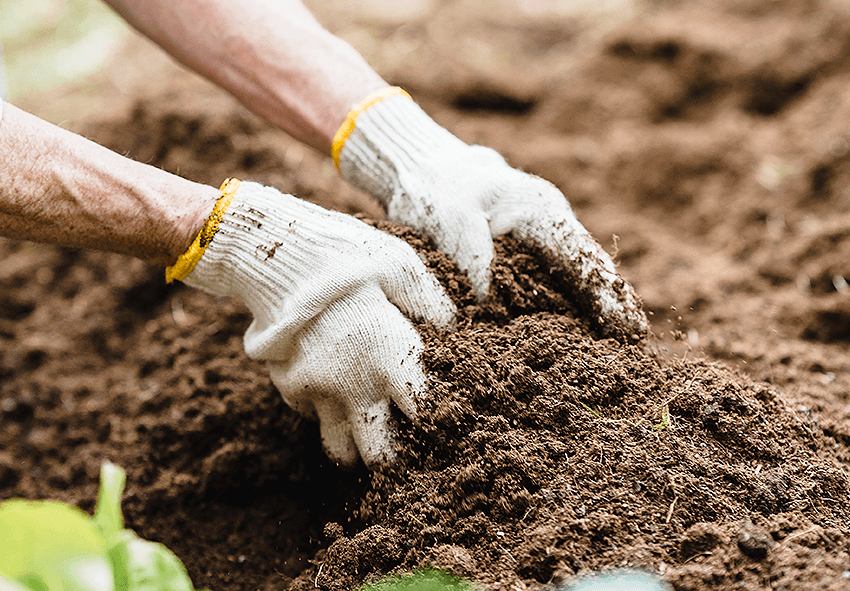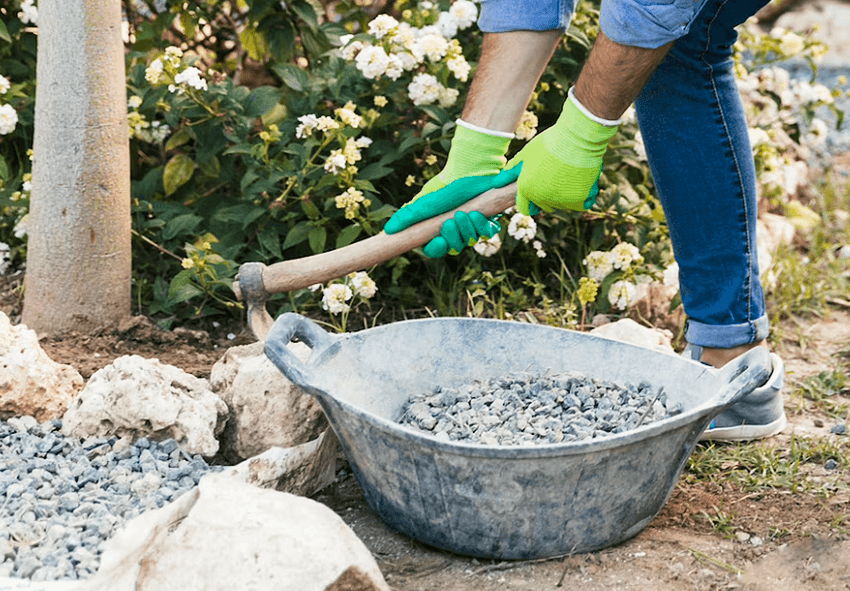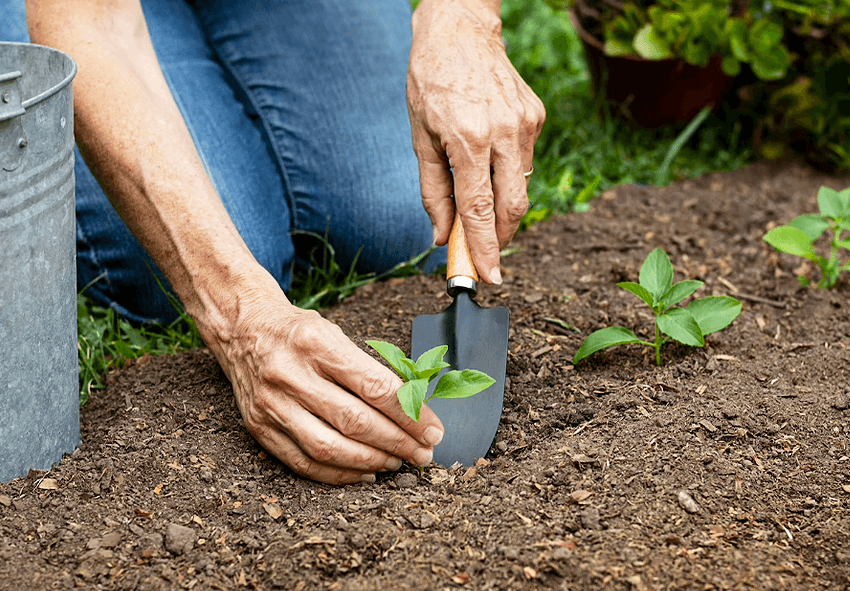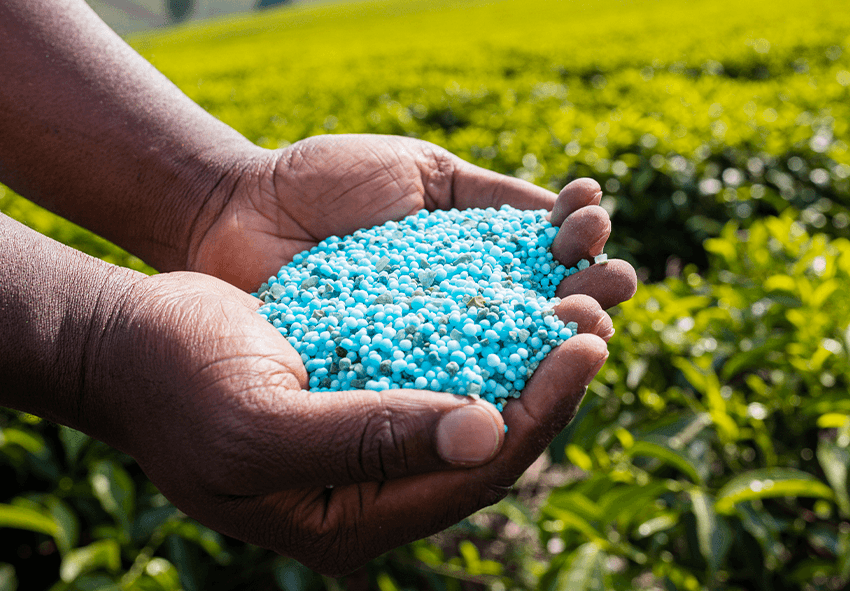Enhancing the physical and chemical characteristics of your soil to make it better suited for plant development is known as soil preparation. Several steps are involved in soil preparation, including:
- Testing your soil pH and nutrient levels
- Adding organic matter and other amendments to improve your soil structure and fertility
- Tilling or aerating your soil to loosen it and enhance drainage
- Creating raised beds or other planting areas to optimize your soil conditions
- Mulching your soil to conserve moisture and suppress weeds
- Fertilizing and watering your soil to provide adequate nutrients and moisture to your plants
- Troubleshooting soil issues such as nutrient deficiencies and soil compaction
By preparing your soil properly, you can ensure that your plants have access to the essential elements they need to thrive. You can also prevent or correct many common problems that affect plant health and yield, such as diseases, pests, weeds, drought, and flooding.
Soil Testing

You must understand the type of soil you have and what it needs before you can begin preparing the ground for a garden. Testing the pH and nutrient levels of your soil is the best way to accomplish this. These two variables can differ greatly depending on your location, climate, and historical land usage. They have a substantial influence on plant development.
Soil pH
Soil pH is a measure of how acidic or alkaline your soil is. It ranges from 0 (very acidic) to 14 (very alkaline), with 7 being neutral. Most plants prefer a slightly acidic to neutral soil pH (between 6 and 7), but some may have different preferences depending on their species and variety.
Soil pH affects the availability of nutrients in the soil. Some nutrients are more soluble in acidic soils, while others are more soluble in alkaline soils. If your soil pH is too high or too low, some nutrients may become unavailable or toxic to your plants.
To test your soil pH, you can use a simple kit that you can buy at any garden center or online. You can also send a sample of your soil to a local extension service or a private laboratory for a more accurate analysis.
If your soil pH is not within the optimal range for your plants, you can adjust it by adding amendments. To lower your soil pH (make it more acidic), you can add sulfur, peat moss, pine needles, or organic matter. To raise your soil pH (make it more alkaline), you can add lime, wood ash, or crushed eggshells.
However, be careful not to overdo it. Changing your soil pH too drastically or too quickly can harm your plants and disrupt the balance of microorganisms in the soil. It is better to make gradual changes over time and monitor the results with regular testing.
Soil Nutrients
Plants require nutrients from the soil in order to develop and carry out a variety of tasks. Plants require a lot of nitrogen (N), phosphorus (P), and potassium (K), the three main macronutrients. In lower quantities, plants also require a number of other macronutrients and micronutrients, including calcium (Ca), magnesium (Mg), sulfur (S), iron (Fe), zinc (Zn), copper (Cu), manganese (Mn), boron (B), molybdenum (Mo), chlorine (Cl), cobalt (Co), nickel (Ni), and selenium (Se).
Soil nutrients affect various aspects of plant growth, such as:
- Nitrogen: promotes leafy growth and green color
- Phosphorus: stimulates root development and flowering
- Potassium: enhances fruit quality and disease resistance
- Calcium: strengthens cell walls and regulates nutrient uptake
- Magnesium: activates enzymes and chlorophyll production
- Sulfur: aids in protein synthesis and flavor
- Iron: essential for chlorophyll formation and oxygen transport
- Zinc: involved in hormone production and enzyme activity
- Copper: required for photosynthesis and respiration
- Manganese: activates enzymes and assists in chlorophyll synthesis
- Boron: regulates carbohydrate metabolism and cell division
- Molybdenum: essential for nitrogen fixation and nitrate reduction
- Chlorine: involved in osmosis and ionic balance
- Cobalt: necessary for nitrogen fixation and vitamin B12 synthesis
- Nickel: involved in urea breakdown and iron absorption
- Selenium: acts as an antioxidant and protects against stress
You may use a straightforward kit that you can get at any garden shop or online to evaluate the amounts of nutrients in your soil. You can also send a sample of your soil to a private laboratory or a nearby extension department for a more thorough examination.
You may improve your soil’s nutrient levels by adding organic matter, fertilizers, or other soil amendments if they are insufficient for your plants. But be careful not to go overboard. Your plants may experience imbalances, deficits, or toxicities if you provide too much of any nutrient. It is best to abide by the suggestions made in light of your soil test findings and your plants’ requirements.
Soil Preparation

You are ready to get your soil ready for planting after testing and amending it. In order to improve the soil’s structure and make it more hospitable to plant development, soil preparation entails loosening the soil. Additionally, soil preparation aids in aeration, drainage improvement, weed control, and erosion prevention.
Tilling or Aerating
Tilling or aerating your soil is the process of breaking up the soil and mixing it with organic matter and other amendments. Tilling or aerating your soil can help to:
- Loosen compacted soil and improve its texture
- Incorporate organic matter and nutrients into the soil
- Eliminate weeds and pests from the soil
- Create a smooth and level surface for planting
However, tilling or aerating your soil is not always necessary or beneficial.
Therefore, you should only till or aerate your soil when it is needed.
You should also avoid tilling or aerating your soil when it is too wet or too dry. Tilling wet soil can cause it to clump together and form hard crusts when it dries. Tilling dry soil can cause it to lose moisture and become dusty. The best time to till or aerate your soil is when it is moist but not soggy.
Improving Soil Structure
Soil structure refers to how the soil particles are arranged and held together. Soil structure affects how well the soil can hold water, air, nutrients, and roots. Good soil structure is crumbly and granular, with plenty of pore spaces between the particles. Poor soil structure is dense and compacted, with few pore spaces between the particles.
Improving your soil structure can help to:
- Increase water infiltration and retention in the soil
- Improve air circulation and oxygen availability in the soil
- Enhance nutrient availability and uptake in the soil
- Facilitate root growth and development in the soil
You can improve your soil structure by adding organic matter and other amendments to your soil. Organic matter is any material that comes from living organisms, such as compost, manure, leaves, grass clippings, straw, wood chips, etc.
However, be careful not to add too much of any amendment to your soil. Adding too much of any amendment can cause imbalances, deficiencies, or toxicities in your soil and plants. It is better to follow the recommendations based on your soil test results and the needs of your plants.
Creating Raised Beds or Other Planting Areas
Creating raised beds or other planting areas can help you optimize your soil conditions and make your gardening easier and more productive. Raised beds are simply mounds of soil that are elevated above the ground level, usually surrounded by some kind of border, such as wood, stone, brick, metal, etc. Other planting areas include containers, pots, baskets, boxes, etc.
Mulching

Mulching is the process of covering your soil with a layer of organic or inorganic material. Mulching can help you conserve moisture and suppress weeds in your garden. Mulching can also help you improve your soil quality over time by adding organic matter and nutrients to your soil.
Some of the benefits of mulching include:
- Reducing water evaporation and runoff from the soil
- Moderating soil temperature and preventing frost damage
- Preventing weed germination and growth
- Reducing soil erosion and compaction
- Enhancing soil fertility and structure
- Attracting beneficial insects and microorganisms to the soil
- Adding aesthetic appeal to your garden
Some of the common materials used for mulching include:
- Organic mulches: compost, manure, leaves, grass clippings, straw, wood chips, bark, pine needles, etc.
- Inorganic mulches: gravel, stone, pebbles, plastic, fabric, etc.
To apply mulch to your garden, you should follow several steps. First of all you need to weed your garden thoroughly before mulching, than water your garden well before mulching/ After that spread a layer of 2 to 4 inches of mulch around your plants, leave some space around the base of your plants to prevent rotting or disease and replenish or replace your mulch as needed throughout the season.
Soil Maintenance
You must maintain your soil throughout the growth season after you have prepared it for planting. Soil maintenance is giving your plants enough nutrients and moisture while also preserving your soil from weeds, pests, diseases, and environmental stress:
Fertilizing
Fertilizing is the process of adding nutrients to your soil to supplement its natural fertility. Fertilizing can help you boost your plant growth and yield by providing them with the essential elements they need. Fertilizing can also help you correct or prevent nutrient deficiencies or imbalances in your plants.
Some of the benefits of fertilizing include increasing plant vigor and resistance to stress; enhancing flower production and fruit quality; improving plant color and flavor; extending plant life span and harvest period.
Some of the common types of fertilizers include:
- Organic fertilizers: derived from plant or animal sources, such as compost, manure, blood meal, bone meal, fish emulsion, seaweed extract, etc.
- Inorganic fertilizers: synthesized from mineral or chemical sources, such as urea, ammonium nitrate, potassium chloride, superphosphate, etc.
- Slow-release fertilizers: coated or encapsulated with a material that releases nutrients gradually over time
- Liquid fertilizers: dissolved or suspended in water and applied directly to the soil or foliage
- Granular fertilizers: solid particles that are spread on the soil surface or mixed into the soil
To apply fertilizer to your garden, you should follow several steps. First of all you need to test your soil nutrient levels and pH before fertilizing. Then choose the right type and amount of fertilizer for your plants and soil. After that follow the instructions on the fertilizer label or package. You need to apply fertilizer at the right time and frequency for your plants and soil, water your garden well after fertilizing to dissolve and distribute the nutrients and avoid over-fertilizing or under-fertilizing your plants.
Watering and Drainage

Watering and drainage are two aspects of soil moisture management that are crucial for plant growth. Watering is the process of providing water to your plants when they need it. Drainage is the process of removing excess water from your soil when it is too wet.
Some of the benefits of watering and drainage include:preventing drought stress and wilting in your plants; promoting root growth and nutrient uptake in your plants; preventing water logging and root rot in your plants; improving soil aeration and microorganism activity in your soil.
Some of the common methods of watering and drainage include:
- Hand watering: using a hose, a watering can, or a bucket to water your plants by hand.
- Sprinkler irrigation: using a device that sprays water over your plants in a circular or rectangular pattern.
- Drip irrigation: using a system of tubes or hoses that deliver water directly to the base of your plants.
- Raised beds: elevating your planting area above the ground level to improve drainage.
- Drain tiles: installing perforated pipes or tubes under your planting area to collect and divert excess water.
- French drains: digging a trench filled with gravel or rock under or around your planting area to collect and divert excess water.
To water and drain your garden properly, you should follow some steps: monitor your soil moisture level regularly by feeling it with your fingers or using a moisture meter; water your plants when the top 1 to 2 inches of soil feel dry to the touch; water your plants deeply and thoroughly until water drains out of the bottom of the container or bed; water your plants early in the morning or late in the evening to reduce evaporation and prevent leaf scorch; avoid watering your plants too frequently or too infrequently; choose a watering method that suits your plants, soil, climate, and budget; improve your soil drainage by adding organic matter, sand, gravel, or other amendments; create raised beds or other planting areas to elevate your soil above the water table; install drain tiles or French drains to collect and divert excess water away from your planting area.
Troubleshooting Soil Issues
Even if you prepare and maintain your soil well, you may still encounter some issues that affect your plant growth and yield. Some of the common soil issues include nutrient deficiencies and soil compaction. These issues can be identified by observing the symptoms in your plants or testing your soil.
Soil Compaction
Soil compaction occurs when soil particles are pressed closely together, narrowing the pore spaces between them. Heavy foot activity, machinery use, over-tilling, over-watering, and clay content can all create soil compaction.
Soil compaction can affect plant growth by restricting root penetration and expansion in the soil, reducing water infiltration and retention in the soil, impeding air circulation and oxygen availability in the soil, limiting nutrient availability and uptake in the soil.
Some of the signs of soil compaction include: slow drainage and waterlogging in the soil; cracks or crusts on the soil surface; difficulty inserting tools or fingers into the soil; stunted or yellowing plant growth.
To prevent or correct soil compaction, you can:
- Avoid walking or driving on your planting area as much as possible
- Use mulch to protect your soil surface from rain impact and erosion
- Add organic matter to improve your soil structure and porosity
- Aerate your soil by using a fork, a spade, a rake, a rototiller, an aerator, or other tools to loosen it up
Nutrient Deficiencies

Nutrient deficiencies are the condition where your plants do not have enough of one or more nutrients to grow and perform well. Nutrient deficiencies can be caused by various factors, such as low soil fertility, high or low soil pH, poor drainage, root damage, or pest infestation.
Nutrient deficiencies can affect plant growth by reducing plant vigor and resistance to stress, impairing flower production and fruit quality, altering plant color and flavor, shortening plant life span and harvest period.
Some of the signs of nutrient deficiencies include:
- Chlorosis: yellowing of leaves or veins due to lack of chlorophyll
- Necrosis: browning or dying of leaf margins or tips due to cell death
- Purpling: reddening or purpling of leaves or stems due to accumulation of anthocyanin
- Stunting: reduced plant size or growth rate due to lack of energy
- Distortion: curling, twisting, or wilting of leaves or stems due to abnormal cell division
- Spots: dark or light spots on leaves or fruits due to fungal or bacterial infection
To prevent or correct nutrient deficiencies, you can test your soil nutrient levels and pH regularly and amend them as needed, choose the right type and amount of fertilizer for your plants and soil, apply fertilizer at the right time and frequency for your plants and soil, water your plants well after fertilizing to dissolve and distribute the nutrients, avoid over-fertilizing or under-fertilizing your plants.
Conclusion
Soil preparation and maintenance are essential for a successful garden. By following these steps, you can create a fertile and productive soil that will support your plants throughout the growing season. You can also prevent or solve many common problems that affect plant health and yield.
Remember that soil is a living system that changes over time. As a result, you must constantly monitor your soil and adjust your efforts accordingly. This will keep your soil healthy and productive for many years to come.
This post should have taught you how to prepare soil for gardening. Best wishes for your planting!
Frequently Asked Questions (FAQs) about Preparation and Maintenance
1. Can I order Holland plants from your online store for my garden?
At our online store, we offer a wide range of plants and flowers. You can conveniently browse our selection, compare products, and place orders online. We strive to provide quality plants to help you create your dream outdoor space.
2. What's the best time to start preparing my garden for new plants?
The ideal time for garden preparation largely depends on your local climate and the types of plants you want to grow. In general, spring and early fall are excellent times to start preparing your garden. Spring allows you to get a head start on planting as the weather warms up and the soil thaws, while early fall provides a second opportunity to plant before winter sets in. However, it’s crucial to research the specific planting times for the plants you intend to grow, as some may have unique requirements. Remember that good preparation, including soil testing, amending, and planning, is key to successful gardening regardless of the season.
3. What are some essential tools and equipment for maintaining a healthy garden?
Maintaining a healthy garden requires a few essential tools and equipment, including:
- Hand Trowel and Pruners: These are handy for planting, weeding, and pruning.
- Garden Gloves: Protect your hands while working in the garden.
- Watering Can or Hose: Ensure your plants receive adequate moisture.
- Mulch: Helps retain soil moisture and suppress weeds.
- Shovel and Rake: Useful for digging, leveling, and spreading mulch.
- Wheelbarrow: Transport soil, compost, and plants with ease.
- Pesticides and Fertilizers: Choose organic or chemical options depending on your preference.
- Garden Shears: Trim and shape your plants as needed.
Investing in quality tools will make your gardening tasks more manageable and enjoyable.
4. How do I prevent common garden pests and diseases in my plants?
Preventing garden pests and diseases starts with good gardening practices. Maintain plant health by providing proper care, including adequate watering and appropriate fertilization. Practice crop rotation to reduce the risk of soil-borne diseases and avoid planting susceptible species in close proximity to each other. Regularly inspect your plants for signs of pests or diseases, and promptly address any issues you identify. Consider using natural pest control methods like beneficial insects, companion planting, or organic pesticides if problems persist. Staying vigilant and taking preventive measures can help keep your garden thriving.
5. Can you recommend low-maintenance plants for beginners?
Certainly! If you’re new to gardening, start with low-maintenance plants that are forgiving and require minimal care. Some excellent options include:
- Succulents and Cacti: These are drought-tolerant and thrive on neglect.
- Herbs: Basil, mint, and rosemary are relatively easy to grow.
- Annual Flowers: Marigolds, zinnias, and petunias provide vibrant blooms with minimal effort.
- Perennials: Daylilies, coneflowers, and hostas are hardy and return year after year.
- Shrubs: Dwarf varieties like boxwood and spirea are low-maintenance and add structure to your garden.
Published: 01.05.2023
